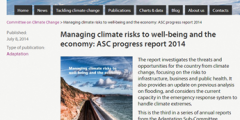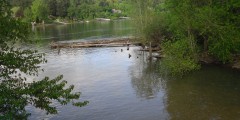Urban Fluvial Geomorphology
January 23, 2018
After completing her PhD in fluvial geomorphology at Cranfield University together with Arup and Leeds City Council on the Leeds Flood Alleviation Scheme, Kim joined the EPSRC Urban Flood Resilience research consortium in October 2017. In this blog post, she reflects on how insights from fluvial geomorphology can be applied to the urban environment in …
How are transport networks going to become more resilient to flood risk?
November 30, 2017
In this blog, Dr David Dawson examines flood risk on the physical transport network and some potential developments for improving urban flood risk by connecting multiple infrastructure systems. Plumber, ‘Sorry Transport Secretary, you have a leak!’ Transport Secretary, ‘Well, how bad is it?’ The Issue The extent of flood risk across our transport networks is …
Malmö: two decades at the cutting edge of innovative water management
September 1, 2017
In this blog Shaun Maskrey investigates how Malmö became Europe’s poster child blue-green city following almost 20 years at the forefront of innovative water management. Sustainable urban drainage systems (SUDS) are a common sight in central Malmö The Issue In the late 1990s, after years of socio-economic decline and flooding as a result of overwhelmed drainage, …
Restoring the Dignity of Rivers
August 7, 2017
In this blog, Professor Colin Thorne shares with us his ‘restoring the dignity of rivers’ speech from the River Restoration Northwest Speaker Series given in Seattle, 23 May 2017. ‘everything has either a price or a dignity. Anything that has a price can be replaced by something else as its equivalent, but anything that is above all price, …
How can woodland help reduce flooding?
June 8, 2015
The potential of woodland to prevent flooding has been enthusiastically promoted in recent years, particularly by environmental interest groups such as the Woodland Trust and the WWF (see Woodland Trust, 2012, p13-15 and WWF Scotland, 2007, p2). However, some commentators have questioned the robustness of the link between woodland cover and flooding (see Calder & Aylward, …
Green Infrastructure, Groundwater and the Sustainable City
February 9, 2015
In early November 2014, I had the pleasure of attending a lecture titled ‘Green Infrastructure, Groundwater and the Sustainable City’ given by Professor Larry Band, who is Voit Gilmore Distinguished Professor of Geography and Director of the Institute for the Environment at the University of North Carolina and Visiting Professor, Chinese Academy of Science. The …
Managing climate risks to well-being and the economy: ASC progress report, 9th July 2014
August 4, 2014
Blog post by Emily Lawson, University of Nottingham. On Wednesday 9th July I attended the Adaptation Sub Committee (ASC) annual report launch at the satellite event in Nottingham, organised by Climate UK and Climate East Midlands. The report, titled “Managing climate risks to well-being and the economy”, was summarised in a presentation from Lord John Krebs, …
Restoring the Dignity of Johnson Creek (Portland, Oregon)
June 10, 2014
This is the second of our audio blogs and presents the after dinner speech given by Professor Colin Thorne (University of Nottingham) at the Annual Assembly of the Johnson Creek Watershed Council (JCWC), 22 May 2014, hosted at Reed College, Portland, Oregon. Colin and the Blue-Green Cities Team were in Portland in May 2014 as part …
Nick Mount talks drainage in São Paulo, Brazil (audio blog)
January 31, 2014
Presenting the first Blue-Green Cities audio blog! Emily Lawson and Nick Mount (School of Geography, University of Nottingham) discuss the current drainage structure in São Paulo, Brazil, and potential for future implementation measures to reduce the flood risk and transform the character of the city while delivering multiple benefits to the region. Go to audio blog. …









